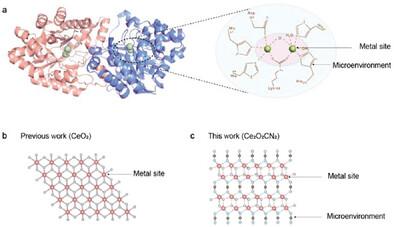Bioinspired Cerium Nanozyme Microenvironment Regulation for Efficient Dephosphorylation and Detection of Organophosphorus Pesticides
IF 13
2区 材料科学
Q1 CHEMISTRY, MULTIDISCIPLINARY
引用次数: 0
Abstract
Mimicking the structure of natural enzyme active sites offers a promising strategy for the rational design of nanozymes. However, this biomimetic approach predominantly focuses on replicating the configuration of the metal active center in natural enzymes, often overlooking the critical influence of the catalytic site's microenvironment. Here, inspired by the active center and coordination microenvironment of natural organophosphorus hydrolase (OPH), Ce2O2CN2/NC, a novel cerium-based nanozyme is first reported to mimic OPH. In Ce2O2CN2/NC, Ce species serve as active sites, while the adjacent N site ([N═C═N]2−) functions as a general base, mimicking histidine in natural enzymes to facilitate the hydrolysis process. Using paraoxon as a model target, Ce2O2CN2/NC demonstrates rapid dephosphorylation of phosphotriester across a wide range of temperatures and pH values, significantly outperforming natural OPH and CeO2 nanoparticles. The systematic experiments and theoretical calculations reveal the underlying mechanisms responsible for the enhanced OPH-mimicking performance. Capitalizing on its phosphatase-like activity, Ce2O2CN2/NC nanozyme is successfully employed to develop a colorimetric biosensor for the rapid and selective detection of organophosphorus pesticides. This study holds great promise in developing efficient nanozymes and broadens the range of Ce-based nanozymes.

求助全文
约1分钟内获得全文
求助全文
来源期刊

Small
工程技术-材料科学:综合
CiteScore
17.70
自引率
3.80%
发文量
1830
审稿时长
2.1 months
期刊介绍:
Small serves as an exceptional platform for both experimental and theoretical studies in fundamental and applied interdisciplinary research at the nano- and microscale. The journal offers a compelling mix of peer-reviewed Research Articles, Reviews, Perspectives, and Comments.
With a remarkable 2022 Journal Impact Factor of 13.3 (Journal Citation Reports from Clarivate Analytics, 2023), Small remains among the top multidisciplinary journals, covering a wide range of topics at the interface of materials science, chemistry, physics, engineering, medicine, and biology.
Small's readership includes biochemists, biologists, biomedical scientists, chemists, engineers, information technologists, materials scientists, physicists, and theoreticians alike.
 求助内容:
求助内容: 应助结果提醒方式:
应助结果提醒方式:


